Click on images to enlarge
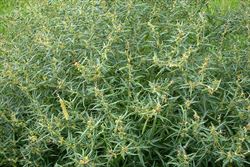
habit (Photo: Sheldon Navie)
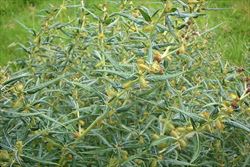
habit (Photo: Sheldon Navie)
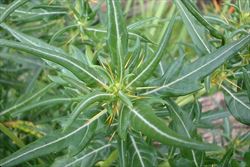
upper leaves with dark green upper surfaces, prominent whitish veins and slightly three-lobed margins (Photo: Sheldon Navie)
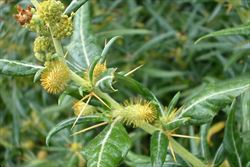
rounded male flower-heads borne above the spiny female flower-heads, also note the large yellow three-pronged spines in the leaf forks (Photo: Sheldon Navie)
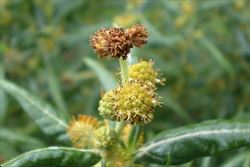
close-up of yellowish male flower-heads clustered at the tips of the branches (Photo: Sheldon Navie)
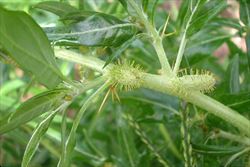
close-up of hairy stems, paler leaf undersides, and immature fruit borne singly in the upper leaf forks (Photo: Sheldon Navie)
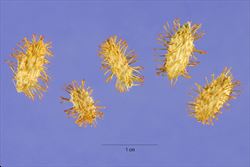
close-up of burrs covered in hooked spines (Photo: Steve Hurst at USDA PLANTS Database)
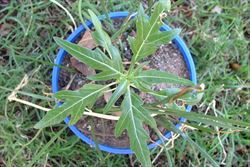
young plant, with leaves that are more prominently lobed (Photo: Sheldon Navie)
Scientific Name
Xanthium spinosum L.
Family
Asteraceae (Queensland, New South Wales, the ACT, Victoria, Tasmania, Western Australia and the Northern Territory)Compositae (South Australia)
Common Names
Bathurst burr, burrweed, burweed, cat's eggs, clotbur, cocklebur, common cockleburr, dagger, dagger cocklebur, dagger weed, daggerweed, prickly burrweed, Spanish thistle, spiny burweed, spiny clotbur, spiny cocklebur, spiny cockleburr, spring clotbur, thorny burweed
Origin
Native to some parts of
Naturalised Distribution
This species is very widely naturalised in Australia, particularly in the eastern half of the country. It is most common in New South Wales, the ACT, Queensland, Victoria and south-eastern South Australia, but is also scattered in the southern parts of the Northern Territory, in other parts of South Australia and in the southern and south-western parts of Western Australia. It is also occasionally naturalised in Tasmania.
Bathurst burr (Xanthium spinosum) is also widely naturalised in other parts of the world, including Europe, the Azores, Africa, temperate Asia, Papua New Guinea, New Zealand, North America (i.e. the USA and Canada) and some parts of South America.
Habitat
A weed of pastures, crops, waterways, grasslands, open woodlands, floodplains, waste areas, roadsides and disturbed sites in temperate, semi-arid, sub-tropical and sometimes also tropical and arid environments.
Habit
An upright (i.e. erect) and much-branched short-lived (i.e. annual) herbaceous plant usually growing 30-100 cm tall, but occasionally reaching up to 1.2 m in height.
Distinguishing Features
- an upright and much-branched herbaceous plant usually growing 30-100 cm tall.
- its stems are armed with yellowish three-pronged spines (15-50 mm long) in the leaf forks.
- its leaves are usually irregularly lobed, with dark green and shiny upper surfaces and pale green lower surfaces covered in downy hairs.
- male flowers are borne in dense clusters near the tips of the stems, while separate female flowers are borne in the leaf forks.
- its stalkless 'burrs' (8-15 mm long) are covered in numerous small hooked spines (2-3 mm long).
Stems and Leaves
The stems are greenish-yellow when young and are covered with fine hairs (i.e. finely pubescent). They are armed with spines that occur singly or in pairs at the base of each leaf stalk (i.e. in the leaf axils). These spines are usually three-pronged from near their bases and may appear to be several spines at first glance. They are yellow or greenish-white in colour with prongs 15-50 mm long.
The alternately arranged leaves (2-10 cm long and 6-30 mm wide) are borne on stalks (i.e. petioles) up to 30 mm long. The lower leaves are usually irregularly three-lobed, or occasionally with five lobes, with the middle lobe much larger than the others. However, on upper leaves the side lobes may be insignificant or absent, thereby giving the leaf blade an elongated (i.e. lanceolate) shape. The leaf upper surfaces are dark green and shiny with prominent whitish-coloured veins, while their undersides are pale green or whitish in colour with a dense covering of downy hairs.
Flowers and Fruit
Separate male and female (i.e. unisexual) flower-heads are produced on different parts of the same plant (i.e. this species is monoecious). Male flower-heads consist of numerous tiny flowers (i.e. florets) that are arranged in dense rounded clusters. These male flower-heads are borne at the tips of the stems, and are yellowish or creamy-white in colour. The greenish-coloured female flower-heads are borne singly or in small clusters in the upper leaf forks (i.e. axils), usually below the male flower-heads. Flowering occurs from late spring through to early autumn, but is most abundant during summer.
The fruit (8-15 mm long and 4-6 mm wide) is greenish when young, later becoming yellowish or straw-coloured, then eventually brownish as it matures. It is an oval-shaped (i.e. ellipsoid) 'burr' containing two seeds. These 'burrs' are stalkless (i.e. sessile), finely hairy, and covered in numerous small hooked spines (2-3 mm long). They also have two small, straight, spines or 'beaks' at the tip (1-2 mm long), which may be difficult to distinguish from the hooked spines. These fruit are mostly formed during late summer and autumn. The brown or black seeds (about 10 mm long) are flattened, and one of each pair is slightly larger than the other.
Reproduction and Dispersal
This species reproduces entirely by seed, contained in the 'burrs'.
These 'burrs' are well adapted for dispersal, due to their hooked spines, and readily become attached to animals, clothing and vehicles. They may also be spread by water and in contaminated agricultural produce.
Environmental Impact
Bathurst burr (Xanthium spinosum) is regarded as an environmental weed in Queensland, the Northern Territory, New South Wales, Victroia and South Australia. It was recently also listed as a priority environmental weed in five Natural Resource Management regions.
Legislation
This species is declared under legislation in the following states and territories:
- ACT: C2 - a pest plant that must be suppressed.
- New South Wales: Class 4 - a locally controlled weed. The growth and spread of this species must be controlled according to the measures specified in a management plan published by the local control authority and the plant may not be sold, propagated or knowingly distributed (in a large number of local authority areas). See the New South Wales Department of Primary Industries Noxious Weeds List at http://www.dpi.nsw.gov.au for more detailed information on which local areas are covered in these declarations.
- Northern Territory: B - spread to be controlled (throughout all of the Territory), and C - not to be introduced into the Territory.
- South Australia: 2@ - this species is listed as a Class 2d weed, and is classified as a dangerous agricultural weed. Control is required throughout the state, and trade and movement is also usually restricted throughout the entire state.
- Tasmania: D - the importation or sale of this species is prohibited and measures to reduce its population in an area, eradicate it from an area, or restrict it to a particular area may be required. This declaration applies to all burr species (Xanthium spp.).
- Victoria: P1 - prohibited and must be eradicated or controlled (in the Port Phillip East region only), and C9 - all reasonable steps must be taken to control the weed and prevent its spread (in the Wimmera, Glenelg, North Central, Corangamite, Port Phillip West, Goulburn, North East, West Gippsland and East Gippsland regions).
- Western Australia: P1 - trade, sale or movement of this species or its seeds is prohibited (throughout the entire state), P2 - to be eradicated (throughout the whole of the state, except for the Coolgardie and Kalgoorlie/Boulder local authority areas), and P3 - this species cannot be eradicated in the short term, but must be kept under 'control' (in the Coolgardie and Kalgoorlie/Boulder local authority areas).
Management
For information on the management of this species see the following resources:
- the Biosecurity Queensland Fact Sheet on this species, which is available online at http://www.dpi.qld.gov.au.
- the Northern Territory Department of Natural Resources, Environment and The Arts Agnote on this species, which is available online at http://www.nt.gov.au/weeds.
- the Western Australian Department of Agriculture and Food Farmnote on this species, which is available online at http://www.agric.wa.gov.au.
- the Tasmanian Department of Primary Industries and Water weed service sheet on this species, which is available online at http://www.dpiw.tas.gov.au.
- the Victorian Department of Primary Industries Landcare Note on this species, which is available online at http://www.dpi.vic.gov.au.
Similar Species
Bathurst burr (Xanthium spinosum) is similar to cockleburr (Xanthium ambrosioides) and the plants of the Noogoora burr complex (Xanthium strumarium sp. agg., which includes Xanthium occidentale, Xanthium orientale, Xanthium italicum and Xanthium cavanillesii ). These species can be distinguished by the following differences:
- Bathurst burr (Xanthium spinosum) has small to moderately sized leaves (2-10 cm long) that are relatively narrow (6-30 mm wide) and usually have three irregular lobes. These leaves have dark green upper surfaces and whitish coloured undersides. Its stems bear three-pronged spines near the leaf bases and its moderately-sized fruit (8-15 mm long) have 'beaks' that are small (1-2 mm long) or absent.
- cockleburr (Xanthium ambrosioides) has small leaves (2-4 cm long) that are very narrow (3-10 mm wide) and usually have three elongated lobes. Both leaf surfaces are finely hairy (i.e. pubescent) and greyish-green in colour. Its stems bear three-pronged spines near the leaf bases and its small fruit (4-8 mm long) usually do not have 'beaks' (occasionally one small 'beak' is present).
- the plants of the Noogoora burr complex (Xanthium strumarium sp. agg.) have relatively large leaves (up to 20 cm long) that are very broad (up to 18 cm across) and often have three or five lobes with irregularly toothed margins. Both leaf surfaces are green in colour and rough to the touch (i.e. scabrous). Their stems do not bear any spines and their relatively large fruit (7-30 mm long) are topped with two distinct 'beaks' (4-8 mm long).

